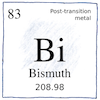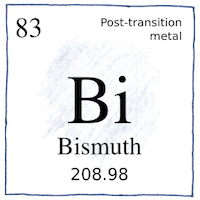Egypt, Greece, Rome, China, France
elements

|
Bismuth
Some confusion remains regarding the confusion of bismuth with lead, tin, antimony, and zinc in ancient times. We believe the Egyptians used it as a cosmetic. Bismuth is one of the sixteen elements known to alchemists and we don’t know what they thought of it. It’s hard to find mention of it elsewhere and of course they didn’t call it bismuth. Early Europeans mined it for use in pigments. Bismuth vanadate is a bright yellow pigment. Today bismuth oxychloride is in pearlescent cosmetics, and bismuth subsalicylate in Pepto-Bismol® and Kaopectate®.
Atomic number 83
Bismuth was known by alchemists and metallurgists before the first millennium. Paracelsus described bismuth and zinc and gave zinc its name in 1526. Georgius Agricola described bismuth in De Natura Fossilium in 1548. Johann Heinrich Pott, Carl Wilhelm Scheele, and Torbern Olof Bergman worked on the problem. Claude François Geoffroy, in 1753, was the first to prove it was a separate element.
Too soon
At the bismuth mines near the town of Schneeberg in Erzgebirgskreis (the mountainous ore district in Saxony), miners around 1477 were familiar with ores for silver and three kinds of lead—ordinary lead, “white lead,” that is, tin, and tectum argenti, or “silver being made,” that is, bismuth. The alchemists taught the transmutation of elements, that all metals tended toward gold, the ideal, so that these three metals were tending toward silver in that order—lead, tin, bismuth, then silver. Consequently, when finding a vein of bismuth, the miners would sadly shake their heads and say, “Alas, we have come too soon.”
Work in progress
It’s ancient, but still a work in progress. Many are patient; others impatient patients. One can only try. Past behavior is not indicative of future performance but no one’s waiting for the end. I’m evolving as fast as I can. In the meantime, in between time, I could use a bit of luck.



The alchemists identified magnesium, phosphorus, sulfur, potassium, iron, copper, zinc, arsenic, silver, tin, antimony, platinum, gold, mercury, lead, and bismuth. Only a hundred or more elements were left.
See also in The book of science:
Readings in wikipedia:
Other readings: